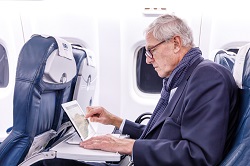New aircraft seat protects passengers’ health
Travelling on aircraft can mean long hours of sitting. This immobility exposes passengers to the risk of developing deep vein thrombosis (DVT), a blood clot that forms in the deep veins of the leg, either in the calf or thigh. Passengers are therefore encouraged to move about on long-haul flights to improve blood circulation. The EU-funded HAIRD project addressed this problem by designing comfortable, healthy next-generation aircraft seating to help reduce the risk of passengers developing DVT during flights. “The lightweight seating is easy to dismantle and includes new materials that are highly recyclable and reliable in structure. Reducing the weight also has direct impact on the aircraft’s fuel consumption and thus its CO2 emissions,” the project scientific coordinator Dr Pere Badalló explains. Cheaper, lighter and easy to recycle Researchers took up the challenge of designing from scratch a new aircraft seat that is better, cheaper and more recyclable than those that are currently on the market. “By employing new materials that are easier to recycle, such as a new polyurethane-based cushion, we can reduce the seating’s environmental impacts,” Dr Badalló points out. The footrest, dynamic seat base, and glass and bottle support are designed to reduce DVT risk, using simple surfaces to facilitate composite manufacturing. In addition, features like the armrest, footrest, headrest, tray table, glass and bottle support and mobile support are designed to be easily dismantled for recycling. Work began with a detailed study of existing aircraft seating and the complex regulations associated with them, using computational tools to ensure weight reduction without compromising structural integrity. The team designed a new mechanical system for seats, allowing fast assembly and disassembly in the aircraft, reducing maintenance times and labour costs. Finally, a life cycle assessment was performed to guarantee improved sustainability of the new design. An innovative approach Composite manufacturing techniques like sheet moulding compounds (SMCs), wet compression moulding (WCM) and prepreg compression moulding (PCM) with co-moulding of SMC were used to design and build the aircraft seat. “As complex geometries are not allowed with WCM and PCM, a new design concept was developed, enabling the use of these techniques for aircraft seating without losing structural reliability,” Dr Badalló clarifies. The result was a new economy class aircraft seat for the Airbus A320 and an improved user experience in airline transport. “The weight of the HAIRD seat is 8.56 kg and 10 kg for economy class and economy class plus respectively. Moreover, 95 % of the weight of the seat is recyclable. It is an attractive yet simple design comprising composite materials that increases passenger comfort, while reducing the risk of DVT,” Dr Badalló concludes. The successful use of composite materials with semi-automatic production techniques to develop an innovative product using state-of-the-art materials makes HAIRD a market leader in next generation seating for aircraft. The project will not only benefit producers of aircraft seating, but also aircraft manufacturers and airline companies by increasing their competitiveness and reducing their carbon footprint.
Keywords
HAIRD, recyclable, deep vein thrombosis (DVT) , composite manufacturing, lightweight







